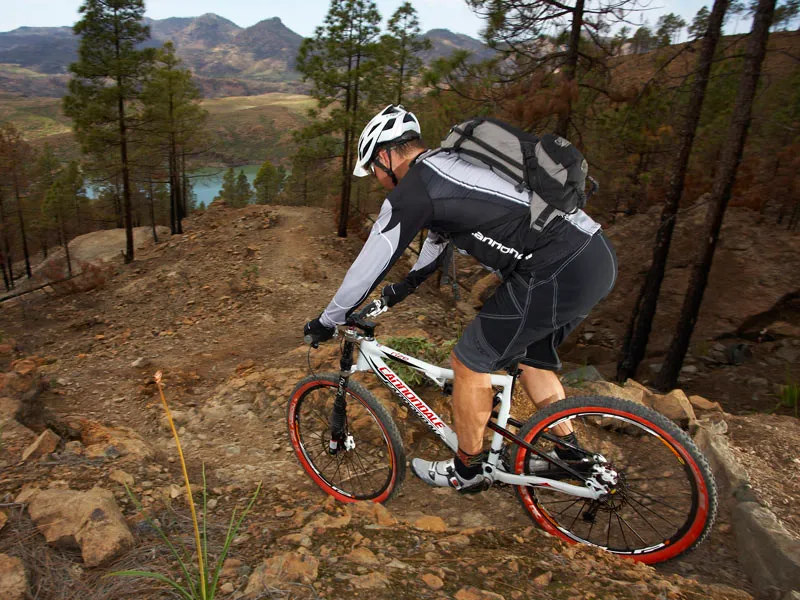With its new duo of long-travel bikes, Cannondale returns to the cross-country/trail bike battlefield dominated by the likes of Specialized, Marin and Giant. The all-mountain Moto and the trail-oriented Rize see Cannondale finally deploy its landing craft to secure a beachhead in this hotly contested arena.
But it's not a totally successful assault. On the one hand, the Moto has Cannondale though the dunes and heading for the nearest town. It perfectly executes Cannondale's System Integration idea - treating the bike as a whole rather than as a collection of plugged-together parts.
On first ride impressions, the 160mm travel Moto is a killer bike, a great all-mountain tool that can actually climb respectably and absolutely nail it on the downs and on undulating singletrack.
The Moto's not the lightest tool in the box, but for its class, the 6.3lb (2.86kg) frame weight is respectable, and is a serious piece of kit for the more gravity-orientated rider. It'll be bouncing mademoiselles on its knee by teatime.
Brothers in arms
On the other hand, the Rize seems to be floundering in the surf, not sure whether to charge up the sand with all guns blazing or take careful pot-shots at the enemy. This is a 130mm travel rig with no pretensions to the hardcore, heavy-hitting stereotype that marketeers have been pushing for the past few years. Or, conversely, to the race-stripped lean machines of the old-school race scene. That’s refreshing, then – so what’s the problem?
Well, it’s understanding where the Rize fits within Cannondale’s line-up. Contrary to other reports, the Rize is not – thankfully – a replacement for the 140mm Prophet trail bike, because the Prophet line is set to run for another two years. Nor is it the 120mm marathon Rush’s new incarnation, although it feels like a Rush with slightly slacker head and seat angles, a higher bottom bracket and 10mm more travel.
The Rize slots in between the Prophet and the Rush and is heavier than the latter, but lighter than the former. It rides very well, which is just as you’d want to ride the Rush in hard and fast techy situations, but without the burl of the Prophet it’s not going to hammer you into trouble and eject you into a world of hurt.
What the Rize does is enable Cannondale to move properly into the mainstream of the trail bike arena, rubbing shoulders with Specialized’s Stumpjumper FSR, Trek’s Fuel EX, Giant’s Trance and Marin’s MountVision. The enigma is not so much the bike itself, but the fact that it has taken Cannondale so long to come up with a true trail bike that can cut it amid such strong competition. But, on first impressions, it has. The Rize is it. At last.
Material concerns
Cannondale has put its carbon and alloy know-how to good use when building the new Moto and Rize, to ensure stiffness yet low weight. Although the complexity of the Moto is out of step with the single-pivot simplicity of recent years, both bikes are fundamentally still single pivot machines, albeit linkage-activated single pivot or ‘faux’ bars.
The Rize is generally rising rate, save towards the end of the travel when it becomes a falling rate in order to squeeze out full travel from the Fox RP shock. This is achieved via the linkage manipulation of the shock ratio through the shock’s travel, and combines pedalling ability with plushness when you most need it — for control and damage-limitation scenarios.
Conversely, the Moto is a little more complex in its suspension configuration. The principle of using a linkage-activated single-pivot design remains the same as for the Rize, but with 30mm more travel to control, Cannondale has opted for what it has dubbed the Hatchet drive link. This is designed to yield better manipulation control over the longer shock stroke. There’s a possibility it could live up to its name by trapping the fingers of riders playing with their shock settings on the fly. However, image and hatchet jobs aside, it goes like stink.
Both frames make use of Cannondale’s immense structural know-how with exotic carbon and alloy construction. The Moto comes with a uni-directional high modulous carbon front triangle mated to an aluminium swingarm with an integrated shock mount. This helps weights range from around 38lb for the Moto Carbon 3, to a very impressive 30lb for the £4500 Moto Carbon Ultimate LTD edition.
The Rize will come in three carbon and two alloy versions, although the alloy versions will still have carbon seatstays. One of the aims of Cannondale’s designers was to make the Rize stiffer than the already stiff Prophet for more efficient pedalling. That’s been achieved by the creation of a 3D forged backbone — combining Cannondale’s proprietary BB30 Si bottom bracket together with the lower pivot, and the double butted seat tube into a single three-dimensionally forged part. Clever stuff.
The carbon front end also benefits from SystemSix carbon technology borrowed from Cannondale’s road bikes for minimum weight and maximum stiffness co-moulded to the backbone. Even the chainstays are flattened to minimise energy loss through pedalling. All in all, it adds up to one stiff machine. Perhaps a little too stiff by many riders’ standards, though, as compliance can be a good thing when it’s built in and controlled, particularly to cope with the vagaries of line choice.
All bikes should be available to British buyers by May 31, here are the UK retail prices:
Moto Carbon Ultimate Ltd - £4,499
Moto Carbon 1 - £3,999
Moto Carbon 2 - £3,399
Moto Carbon 3 - £2,699
Rize Carbon 1 - £5,199
Rize Carbon 2 - £3,999
Rize Carbon 3 - £2,799
Rize 4 - £1,999
Rize 5 - £1,299
For more information, visit www.cannondale.com











